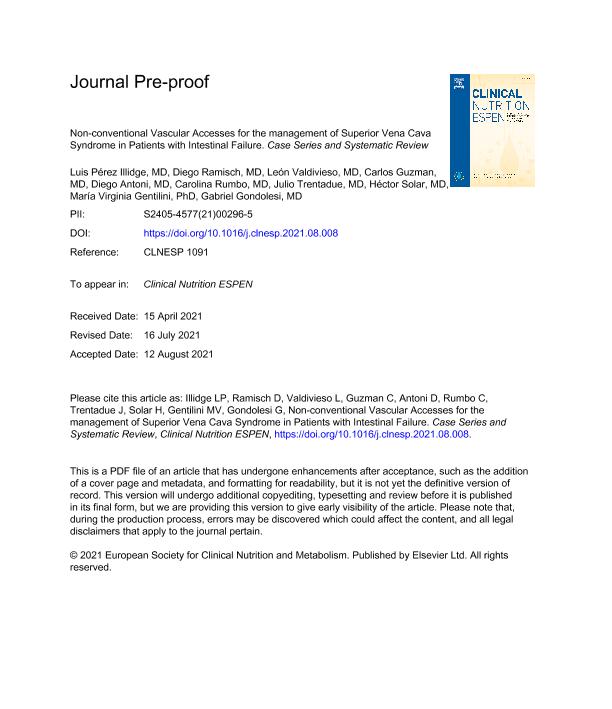Mostrar el registro sencillo del ítem
dc.contributor.author
Pérez Illidge, Luis Carlos
dc.contributor.author
Ramisch, Diego
dc.contributor.author
Valdivieso, León
dc.contributor.author
Guzman, Carlos
dc.contributor.author
Antoni, Diego
dc.contributor.author
Rumbo, Carolina

dc.contributor.author
Trentadue, Julio
dc.contributor.author
Solar, Héctor

dc.contributor.author
Gentilini, Maria Virginia

dc.contributor.author
Gondolesi, Gabriel Eduardo

dc.date.available
2022-12-21T14:06:46Z
dc.date.issued
2021-10
dc.identifier.citation
Pérez Illidge, Luis Carlos; Ramisch, Diego; Valdivieso, León; Guzman, Carlos; Antoni, Diego; et al.; Non-conventional vascular accesses for the management of superior vena cava syndrome in patients with Intestinal Failure: case series and systematic review; Elsevier; Clinical Nutrition ESPEN; 45; 10-2021; 275-283
dc.identifier.issn
2405-4577
dc.identifier.uri
http://hdl.handle.net/11336/181965
dc.description.abstract
Background: Type III Intestinal Failure (IF) is a devastating clinical condition.characterized by the inability of the gut to absorb necessary macronutrients, and/or water and electrolytes, requiring Parenteral Nutrition (PN) as chronic therapy. Long-term PN may lead to life-threatening complications; the loss of central venous access (LCVA) is the most frequent and challenging. To date, few studies in the literature have reported the relevance of Non-conventional Vascular Accesses (NCVA) in the management IF as part of the comprehensive multidisciplinary care. Methods: A retrospective analysis of a database collected from January 2006 to December 2019 was performed using SPSS v25.0 for statistical analysis, followed by a systematic review, using the PRISMA.methodology Results: From January 2006 to December 2019, 184 NCVA were placed in 71 patients with LCVA as IF-related complication; 173 were placed in 61 patients by interventional radiology (IR) and 11 NCVA were placed in 10 patients by the surgical team during the intestinal transplant (ITx) operation. From the 173 IR procedures 166 (95.9%) were successful with 3 ± 2.7 procedures/patient; average catheter permanence rate was 738.68 ± 997 days; complications related to the procedures occurred in 18/173 (10.4%), including two deaths. On the other hand, among the 11 NCVA implanted by the surgical team, 7 (64%) were successful and were safely withdrawn 30 days after ITx when were no longer needed; 2 (18%) catheters malfunctioned during the first week and could not be further used, and 1 was accidently removed; average catheter permanence rate was 26 ± 4 days. There was one complication (9%) requiring laparotomy; there was no mortality associated the procedure in this group. A systematic review was conducted to evaluate the success and safety of NCVA as part of the treatment of HPN-related complications; from 337,542 papers, 14 studies were included. A total of 28 HPN-patients with LCVA received NCVA; 34 procedures were successfully performed, while procedure-related complications were reported in 11.7%, as well as one death. Conclusions: The data analyzed show that NCVAs may be successfully placed by expert teams, allowing to sustain long-term PN, as well as increasing the Intestinal Transplantation applicability for candidates in the extreme need of vascular access.
dc.format
application/pdf
dc.language.iso
eng
dc.publisher
Elsevier

dc.rights
info:eu-repo/semantics/openAccess
dc.rights.uri
https://creativecommons.org/licenses/by-nc-nd/2.5/ar/
dc.subject
HOME PARENTERAL NUTRITION COMPLICATIONS
dc.subject
INTERVENTIONAL RADIOLOGY
dc.subject
LOSS OF VASCULAR ACCESSES
dc.subject
SMALL BOWEL
dc.subject
SUPERIOR VENA CAVA SYNDROME
dc.subject.classification
Trasplantes

dc.subject.classification
Medicina Clínica

dc.subject.classification
CIENCIAS MÉDICAS Y DE LA SALUD

dc.title
Non-conventional vascular accesses for the management of superior vena cava syndrome in patients with Intestinal Failure: case series and systematic review
dc.type
info:eu-repo/semantics/article
dc.type
info:ar-repo/semantics/artículo
dc.type
info:eu-repo/semantics/publishedVersion
dc.date.updated
2022-09-22T00:39:28Z
dc.journal.volume
45
dc.journal.pagination
275-283
dc.journal.pais
Países Bajos

dc.journal.ciudad
Amsterdam
dc.description.fil
Fil: Pérez Illidge, Luis Carlos. Universidad Favaloro; Argentina
dc.description.fil
Fil: Ramisch, Diego. Universidad Favaloro; Argentina
dc.description.fil
Fil: Valdivieso, León. Universidad Favaloro; Argentina
dc.description.fil
Fil: Guzman, Carlos. Universidad Favaloro; Argentina
dc.description.fil
Fil: Antoni, Diego. Universidad Favaloro; Argentina
dc.description.fil
Fil: Rumbo, Carolina. Universidad Favaloro; Argentina
dc.description.fil
Fil: Trentadue, Julio. Universidad Favaloro; Argentina
dc.description.fil
Fil: Solar, Héctor. Universidad Favaloro; Argentina
dc.description.fil
Fil: Gentilini, Maria Virginia. Consejo Nacional de Investigaciones Científicas y Técnicas. Oficina de Coordinación Administrativa Houssay. Instituto de Medicina Traslacional, Trasplante y Bioingeniería. Fundación Favaloro. Instituto de Medicina Traslacional, Trasplante y Bioingeniería; Argentina
dc.description.fil
Fil: Gondolesi, Gabriel Eduardo. Consejo Nacional de Investigaciones Científicas y Técnicas. Oficina de Coordinación Administrativa Houssay. Instituto de Medicina Traslacional, Trasplante y Bioingeniería. Fundación Favaloro. Instituto de Medicina Traslacional, Trasplante y Bioingeniería; Argentina
dc.journal.title
Clinical Nutrition ESPEN
dc.relation.alternativeid
info:eu-repo/semantics/altIdentifier/url/https://www.sciencedirect.com/science/article/pii/S2405457721002965
dc.relation.alternativeid
info:eu-repo/semantics/altIdentifier/doi/http://dx.doi.org/10.1016/j.clnesp.2021.08.008
Archivos asociados
